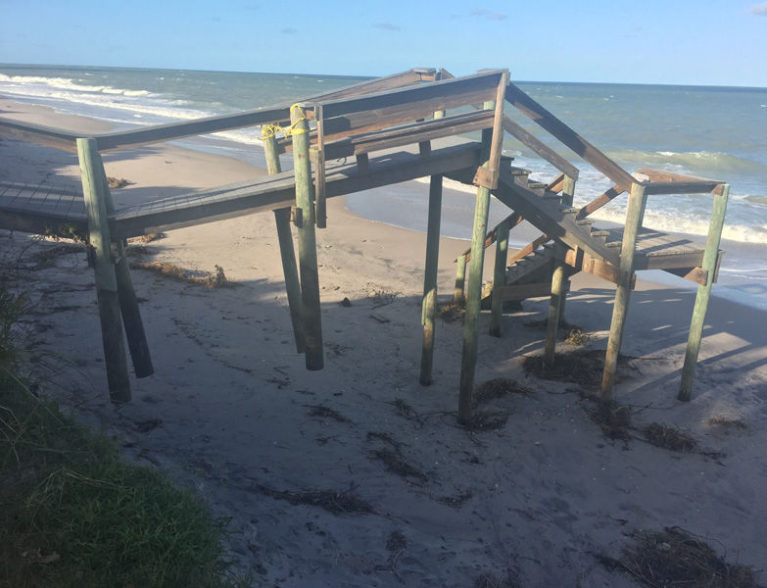
Even though the main force of Hurricane Matthew missed Indian River County, the storm still delivered a powerful blow to ocean beaches and Intracoastal shorelines here, taking a 15-foot chomp out of the dunes along parts of the coast while also destroying docks, ravaging sidewalks and tumbling boats along the north-island stretch of A1A.
Overall, the storm blasted away a couple hundred thousand cubic yards of sand from the county’s signature beaches, causing damage that will cost about $13 million to repair based on initial observations, said James Gray, county coastal engineer.
After inspecting Indian River County’s 22.5 miles of coastline, Gray said, “I would definitely say that we had significant erosion” in multiple areas.
County officials will hire consulting companies to survey the erosion losses and provide exact numbers for sand restoration costs, Gray said.
An Ambersand Beach oceanfront homeowner just south of the Sebastian Inlet, Mercy Yaniz, put it simply about the shoreline behind her house: “We have no beach. We would have to get a ladder to get down to the sand.”
Meanwhile, in the city of Vero Beach, storm-driven waves undermined the boardwalk at Conn Beach south of Jaycee Park and washed out a strip of Ocean Drive, leaving the boardwalk standing on stilts with a deep crevice between it and the damaged roadway.
“The beaches took a major beating,” City Manager Jim O’Connor said. “The sand below the boardwalk has washed away.”
O’Connor said Vero has received a $216,000 bid to backfill sand into the dunes under the popular boardwalk, which remains open, and the city is soliciting additional bids.
O’Connor said the boardwalk is structurally sound, but he warned beach visitors to be careful and not go around orange tape put up to keep people away from dangerous areas or try to jump the gap – which has jagged concrete rubble at the bottom.
Humiston and South Beach parks also received damage, O’Connor said, but it was not as extensive as the damage in the boardwalk area. Waves and storm surge ate up part of the dunes at Humiston, creating a cliff at the edge of the dunes, and O’Connor said the water may have weakened some of the wooden staircases leading down to the beach. Several were blocked with orange tape after the storm.
The city manager did not downplay the severity of the storm’s impact, but said a powerful Nor’easter about three years ago delivered more damage to the city’s coast than Hurricane Matthew.
Elsewhere in the county, several ocean parks were damaged. Golden Sands, Seagrape Trail and Tracking Station parks all suffered structural damage, Gray said.
Some of the worst waterside destruction was on the west side of A1A between the Pelican Island National Wildlife Refuge and the Sebastian Inlet.
Docks on the lagoon were smashed to kindling and boats were wedged between trees and rocks. Sections of the concrete sidewalk collapsed and broke into pieces, with damage threatening the roadway which was closed to traffic part of the day Friday.
“That will be a project in the future I’m sure,” Gray said of further and more extensive repairs to the highway shoulder where it was washed out by wave action and a storm surge that came in the Sebastian Inlet.
Surf was projected to be high the week after the storm, with waves up to eight feet on Wednesday and Thursday, Oct. 12 and 13, which could do more damage to the shore, but Gray said following surf can actually be a benefit sometimes, pushing sand that was washed away back onto the beach.
“After a storm you always look at what impacts are down the road. Sometimes a swell is not a bad thing because it could push the sand that was washed away and assist or accelerate some of the natural recovery to the damaged beaches,” Gray said. On the other hand, “If you have a low berm, the waves could come up to damage the dune again.”
Gray said he is thankful that the erosion damage was not worse.
“It’s bad the way it is, but it could been very, very bad,” he said.
O’Connor put it this way, “We were very, very lucky.”
Gray said residents can report beach damage to the county by calling 772-226-1344. People can get emergency permits for sand placements and dune repair projects by calling the same number.



